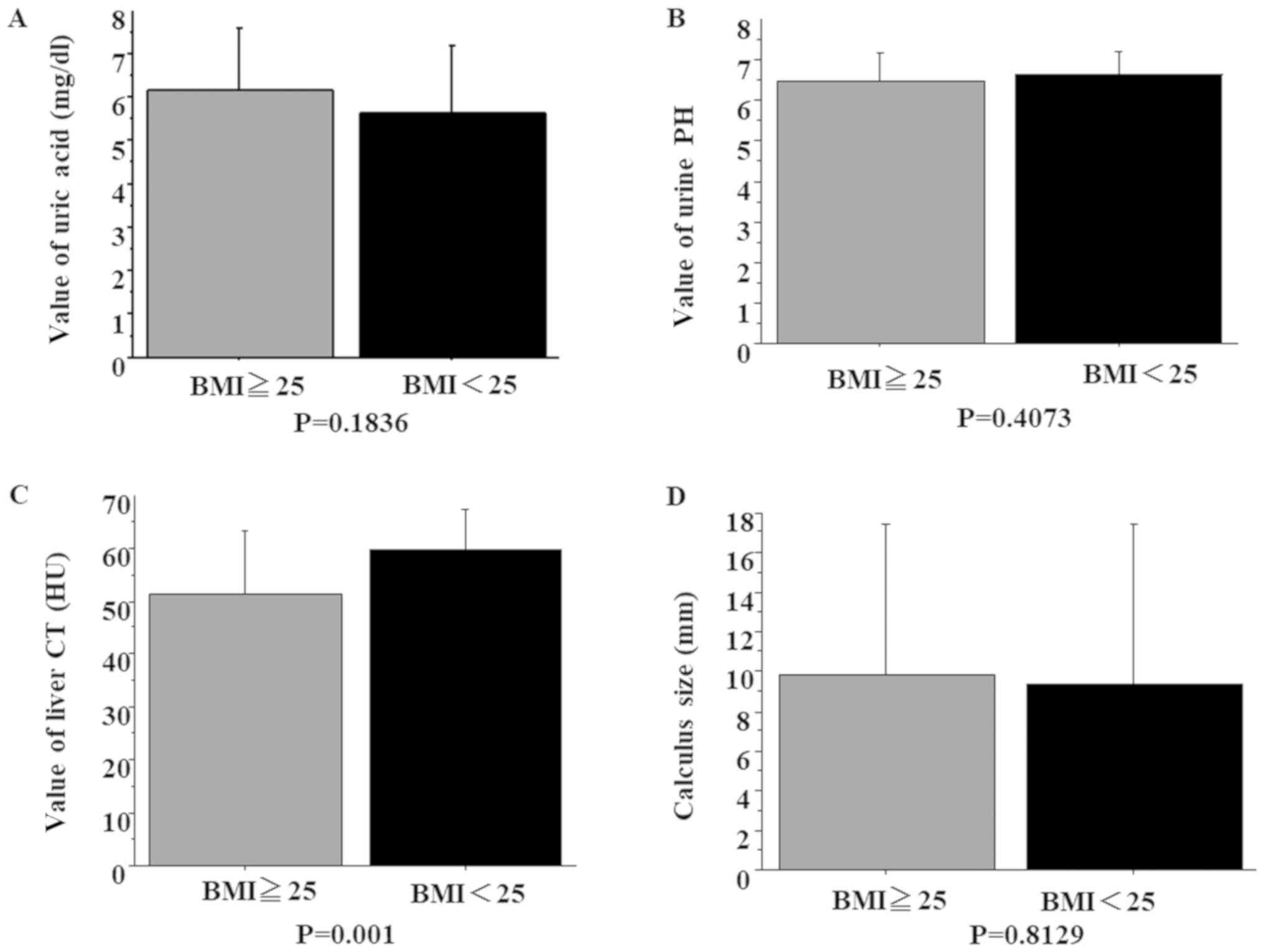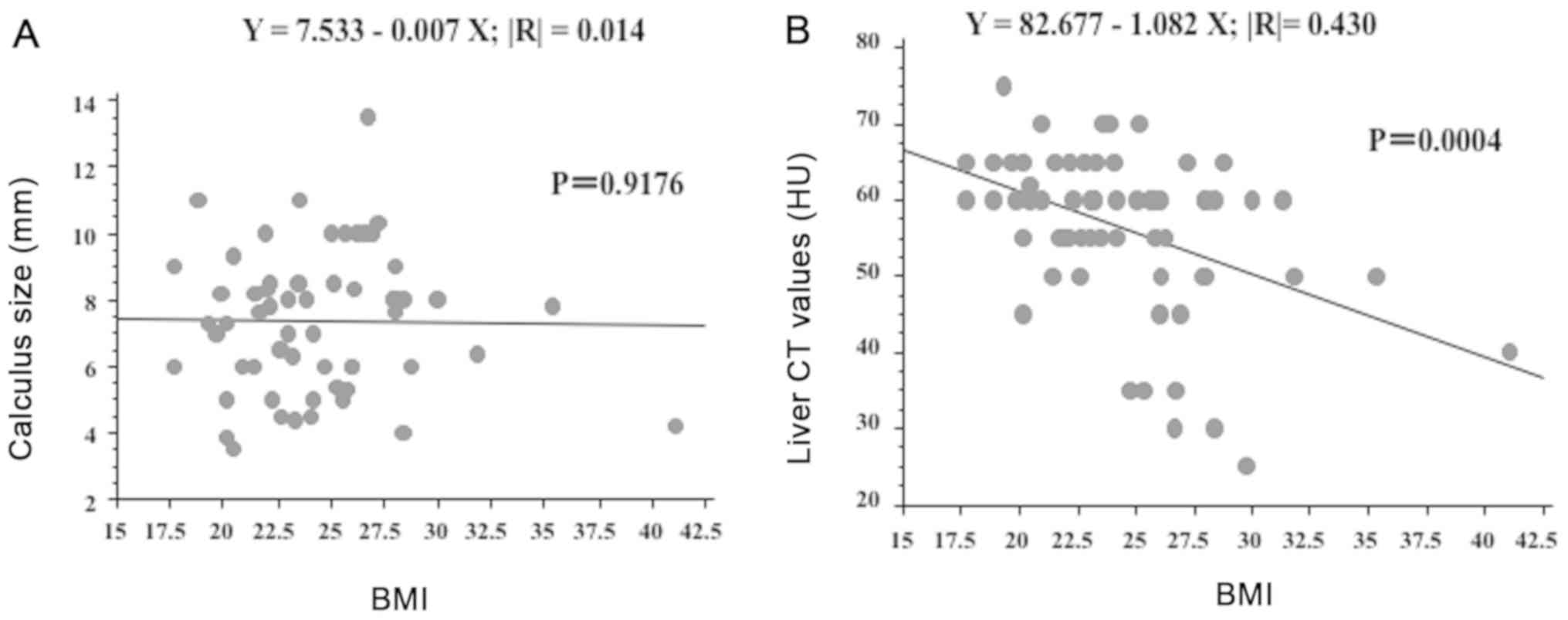|
1
|
Asper R: Epidemiology and socioeconomic
aspects of urolithiasis. Urol Res. 12:1–5. 1984.PubMed/NCBI
|
|
2
|
Yasui T, Iguchi M, Suzuki S and Kohri K:
Prevalence and epidemiological characteristics of urolithiasis in
Japan: National trends between 1965 and 2005. Urology. 71:209–213.
2008.PubMed/NCBI View Article : Google Scholar
|
|
3
|
Pak CY: Kidney stones. Lancet.
351:1797–1801. 1998.PubMed/NCBI View Article : Google Scholar
|
|
4
|
Breslau NA, Brinkley L, Hill KD and Pak
CY: Relationship of animal protein-rich diet to kidney stone
formation and calcium metabolism. J Clin Endocrinol Metab.
66:140–146. 1988.PubMed/NCBI View Article : Google Scholar
|
|
5
|
Curhan GC, Willett WC, Rimm EB and
Stampfer MJ: A prospective study of dietary calcium and other
nutrients and the risk of symptomatic kidney stones. N Engl J Med.
328:833–838. 1993.PubMed/NCBI View Article : Google Scholar
|
|
6
|
Sakhaee K: Nephrolithiasis as a systemic
disorder. Curr Opin Nephrol Hypertens. 17:304–309. 2008.PubMed/NCBI View Article : Google Scholar
|
|
7
|
Sakhaee K and Maalouf NM: Metabolic
syndrome and uric acid nephrolithiasis. Semin Nephrol. 28:174–180.
2008.PubMed/NCBI View Article : Google Scholar
|
|
8
|
Cameron MA, Maalouf NM, Adams-Huet B, Moe
OW and Sakhaee K: Urine composition in type 2 diabetes:
Predisposition to uric acid nephrolithiasis. J Am Soc Nephrol.
17:1422–1428. 2006.PubMed/NCBI View Article : Google Scholar
|
|
9
|
Abate N, Chandalia M, Cab-Chan AV Jr, Moe
OW and Sakhaee K: The metabolic syndrome and uric acid
nephrolithiasis: Novel features of renal manifestation of insulin
resistance. Kidney Int. 65:386–392. 2004.PubMed/NCBI View Article : Google Scholar
|
|
10
|
Maalouf NM, Cameron MA, Moe OW, Adams-Huet
B and Sakhaee K: Low urine pH: A novel feature of the metabolic
syndrome. Clin J Am Soc Nephrol. 2:883–888. 2007.PubMed/NCBI View Article : Google Scholar
|
|
11
|
WHO Expert Consultation: Appropriate
body-mass index for Asian populations and its implications for
policy and intervention strategies. Lancet 363: 157-163, 2004.
|
|
12
|
Bydder GM, Kreel L, Chapman RW, Harry D,
Sherlock S and Bassan L: Accuracy of computed tomography in
diagrosis of fatty liver. Br Med J. 281(1042)1980.PubMed/NCBI View Article : Google Scholar
|
|
13
|
Kan H, Kimura Y, Hyogo H, Fukuhara T,
Fujino H, Naeshiro N, Honda Y, Kawaoka T, Tsuge M, Chayama K, et
al: Non-invasive assessment of liver steatosis in non-alcoholic
fatty liver disease. Hepatol Res. 44:E420–E427. 2014.PubMed/NCBI View Article : Google Scholar
|
|
14
|
Marchesini G, Brizi M, Bianchi G,
Tomassetti S, Bugianesi E, Lenzi M, McCullough AJ, Natale S,
Forlani G and Melchionda N: Nonalcoholic fatty liver disease: A
feature of the metabolic syndrome. Diabetes. 50:1844–1850.
2001.PubMed/NCBI View Article : Google Scholar
|
|
15
|
Maruhama Y, Ohneda A, Tadaki H, Ohtsuki M
and Yanbe A: Hepatic steatosis and the elevated plasma insulin
level in patients with endogenous hypertriglyceridemia. Metabolism.
24:653–664. 1975.PubMed/NCBI View Article : Google Scholar
|
|
16
|
Targher G, Bertolini L, Rodella S, Tessari
R, Zenari L, Lippi G and Arcaro G: Nonalcoholic fatty liver disease
is independently associated with an increased incidence of
cardiovascular event in type 2 diabetic patients. Diabetes Care.
30:2119–2121. 2007.PubMed/NCBI View Article : Google Scholar
|
|
17
|
Taylor EN and Curhan GC: Fructose
consumption and the risk of kidney stones. Kidney Int. 73:207–212.
2008.PubMed/NCBI View Article : Google Scholar
|
|
18
|
Murayama T, Sakai N, Takano T and Yamada
T: Role of the diurnal variation of urinary pH and urinary calcium
in urolithiasis: A study in outpatients. Int J Urol. 8:525–532.
2001.PubMed/NCBI View Article : Google Scholar
|
|
19
|
Sakai N: Recent issues in urolithiasis. J
Analytical Bio Sci. 32:215–219. 2009.
|
|
20
|
Taylor EN, Stampfer MJ and Curhan GC:
Obesity, weight gain, and the risk of kidney stones. JAMA.
293:455–462. 2005.PubMed/NCBI View Article : Google Scholar
|
|
21
|
Ando R, Suzuki S, Nagaya T, Yamada T,
Okada A, Yasui T, Tozawa K, Tokudome S and Kohri K: Impact of
insulin resistance, insulin and adiponectin on kidney stones in the
Japanese population. Int J Urol. 18:131–138. 2011.PubMed/NCBI View Article : Google Scholar
|
|
22
|
Strohmaier WL, Witte B and Nelde HJ:
Influence of nifedipine on stone formation and renal function in
chlesterol-induced nephrolithiasis in rats. Urol Int. 52:87–92.
1994.PubMed/NCBI View Article : Google Scholar
|
|
23
|
Ando R, Nagaya T, Suzuki S, Takahashi H,
Kawai M, Okada A, Yasui T, Kubota Y, Umemoto Y, Tozawa K and Kohri
K: Kidney stone formation is positively associated with
conventional risk factors for coronary heart disease in Japanese
men. J Urol. 189:1340–1346. 2013.PubMed/NCBI View Article : Google Scholar
|
|
24
|
Okada A, Yasui T, Hamamoto S, Hirose M,
Kubota Y, Itoh Y, Tozawa K, Hayashi Y and Kohri K: Genome-wide
analysis of genes related to kidney stone formation and elimination
in the calcium oxalate nephrolithiasis model mouse: Detection of
stone-preventive factors and involvement of macrophage activity. J
Bone Miner Res. 24:908–924. 2009.PubMed/NCBI View Article : Google Scholar
|
|
25
|
Mantovani A, Sica A, Sozzani S, Allavena
P, Vecchi A and Locati M: The chemokine system in diverse forms of
macrophage activation and polarization. Trends Immunol. 25:677–686.
2004.PubMed/NCBI View Article : Google Scholar
|
|
26
|
Zhang MZ, Yao B, Yang S, Jiang L, Wang S,
Fan X, Yin H, Wong K, Miyazawa T, Chen J, et al: CSF-1 signaling
mediates recovery from acute kidney injury. J Clin Invest.
122:4519–4532. 2012.PubMed/NCBI View
Article : Google Scholar
|
|
27
|
Lee S, Huen S, Nishio H, Nishio S, Lee HK,
Choi BS, Ruhrberg C and Cantley LG: Distinct macrophage phenotypes
contribute to kidney injury and repair. J Am Soc Nephrol.
22:317–326. 2011.PubMed/NCBI View Article : Google Scholar
|
|
28
|
Takeuchi H, Tanaka M, Tanaka A, Tsunemi A
and Yamamoto H: Predominance of M2-polarized macrophages in bladder
cancer affects angiogenesis, tumor grade and invasiveness. Oncol
Lett. 11:3403–3408. 2016.PubMed/NCBI View Article : Google Scholar
|
|
29
|
Ichikawa J, Okada A, Taguchi K, Fujii Y,
Zuo L, Niimi K, Hamamoto S, Kubota Y, Umemoto Y, Kohri K, et al:
Increased crystal-cell interaction in vitro under co-culture of
renal tubular cells and adipocytes by in vitro co-culture paracrine
systems simulating metabolic syndrome. Urolithiasis. 42:17–28.
2014.PubMed/NCBI View Article : Google Scholar
|
|
30
|
Taguchi K, Okada A, Kitamura H, Yasui T,
Naiki T, Hamamoto S, Ando R, Mizuno K, Kawai N, Kohri K, et al:
Colony-stimulating factor-1 signaling suppresses renal crystal
formation. J Am Soc Nephrol. 25:1680–1697. 2014.PubMed/NCBI View Article : Google Scholar
|











